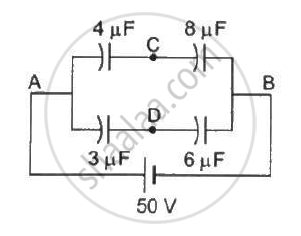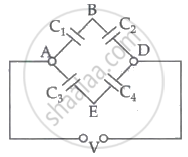Advertisements
Advertisements
Question
Answer the following question.
The magnitude of the electric field (in NC – 1) in a region varies with the distance r(in m) as
E = 10r + 5
By how much does the electric potential increase in moving from point at r = 11 m to a point at r = 10 m.
Solution
point A be given at r = 1 m, point B be given at r = 10 m
VA = potential at A
VB = potential at B
The relation between the electric field and potential difference is given by the relation,
`V_B - V_A = -int_A^B vec"E". d vec"r"`
`V_B-V_A = - int_1^10 (10r+5).dr`
= `-[(10r^2)/2 + 5r]_1^10`
= `-[((10(10)^2)/2 + 5xx 10) - ((10(1)^2)/2 + 5xx1)]`
= `-[550-10]`
= -540 V
APPEARS IN
RELATED QUESTIONS
A point charge +Q is placed at point O, as shown in the figure. Is the potential difference VA – VB positive, negative or zero?

Take the potential of the point B in figure to be zero. (a) Find the potentials at the points C and D. (b) If a capacitor is connected between C and D, what charge will appear on this capacitor?

Electric potential energy of two point charges q and q0 is ________.
It becomes possible to define potential at a point in an electric field because electric field ______.
From a point charge, there is a fixed point A. At A, there is an electric field of 500 V/m and potential difference of 3000 V. Distance between point charge and A will be ______.
A positively charged particle is released from rest in a uniform electric field. The electric potential energy of the charge ______.
The force acting on a particle in one dimension is F = ax - 2xβ3. The corresponding potential energy V(x), assuming V(0) = 0 is given by ______.
If a conductor has a potential V ≠ 0 and there are no charges anywhere else outside, then ______.
- there must be charges on the surface or inside itself.
- there cannot be any charge in the body of the conductor.
- there must be charges only on the surface.
- there must be charges inside the surface.
The electric potential on the axis of an electric dipole at a distance ‘r from it’s centre is V. Then the potential at a point at the same distance on its equatorial line will be ______.
The potential difference between points B and E of the circuits is ______.

